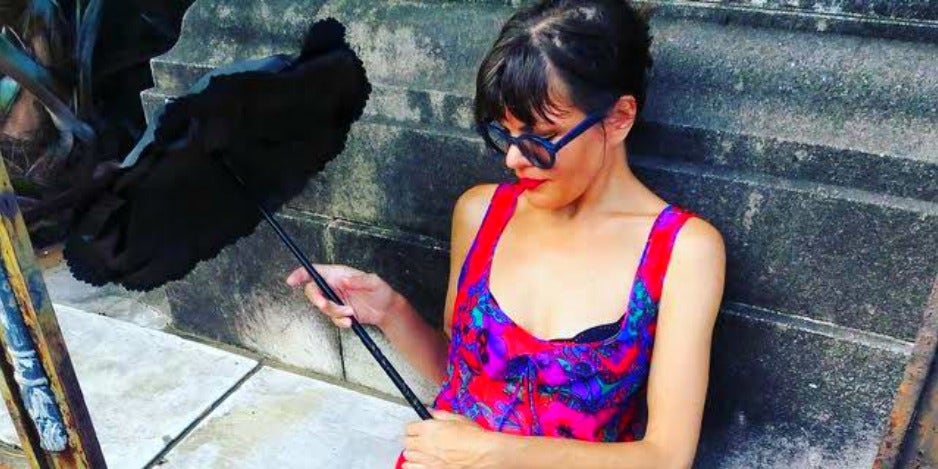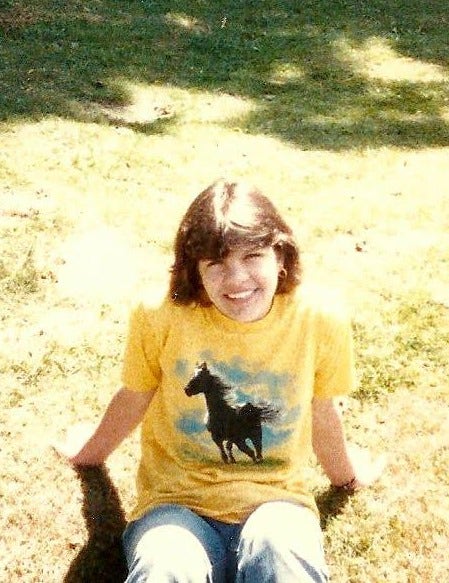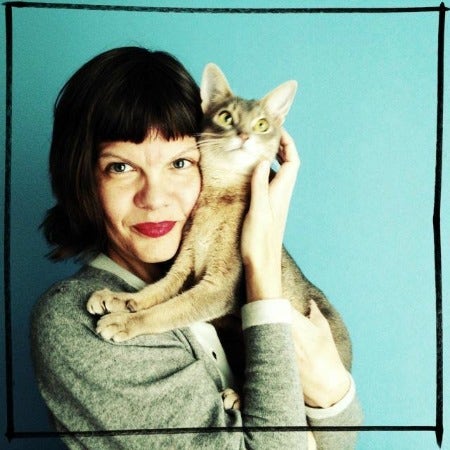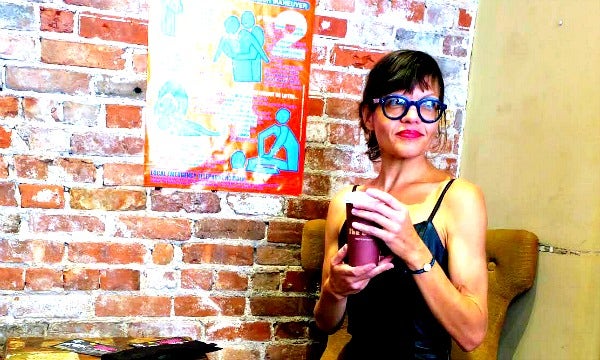How Lipstick And An Experimental Treatment Helped My Depression
Depression leached all the color from my life.
 courtesy of the author
courtesy of the author Four months after my slide into depression became a freefall, I bottomed out in a psychiatric facility.
I barely recognized myself in the facility’s bathroom mirror. My eyes were startled, and my lips were unable to smile. Any attempt at one resulted in a rictus, a twisted grimace, as though I was trying and failing to replicate what I thought a smile should look like. For me, this is what depression feels (and looks) like.
Despite my brain’s inability to do much more than grasp where I was and race around the confines of my skull, desperate to escape, I noticed how colorless my mouth looked. I wasn’t wearing any lipstick.
I always carried a tube of lipstick with me, but I didn’t have access to it at the facility — all but the most anodyne of personal care products were kept by the nurses until patients were discharged. When I approached one nurse deferentially and asked to use my lip balm, she handed it over begrudgingly.
After I was discharged, lipstick — which had once felt essential — now seemed, like everything else, pointless.
Severe depression leaches all color from life. Studies have shown that the retinas of people with depression are less sensitive to visual contrast than those of undepressed people, which means that the absence of color for a depressed person isn’t just figurative, but literal, too.
I eventually found my way out of the monochrome of major depression through a combination of medication, transcranial magnetic stimulation (TMS) which uses devices that, according to Harvard Health, "operate completely outside of the body and affect central nervous system activity by applying powerful magnetic fields to specific areas of the brain that we know are involved in depression," and sheer doggedness.
Without a doubt, my recovery also hinged upon the support of friends and family, tango dancing, and one very unexpected aid: A tube of lipstick.
My fascination with lipstick goes back to the sixth grade when all I wanted was the life-size Barbie Styling Head with its slender neck sloping into an aqua plastic tray for hair accessories and makeup. I asked for it for Christmas, for my birthday, and was rebuffed on every occasion by my mother, who did not approve of makeup.
If I wanted one so badly, she said, I could save up my allowance and buy it myself.
By the time I finally did save up, in the eighth grade, the Barbie head’s appeal had passed. The garish little pats of eye shadow and blush held no interest for me, although I did make desultory attempts at applying them to Barbie’s smooth, less than pliable features.
The tiny tube of waxy pink lipstick did enchant me, though. Maybe because Barbie’s lips were so precisely defined, maybe because there was something satisfying about removing the little cap and holding the tube up to her mouth, as though I were about to feed her.
In junior high, I moved from applying lipstick to Barbie to putting it on myself, although it wasn’t until college that I finally started going out in public wearing it. My mother believed that makeup was frivolous, and my father was equally contemptuous, dismissing it as “crap.”

Photo courtesy of the author
The first tube I purchased, at a cramped drugstore that smelled faintly of Jean Naté, was a harsh, metallic copper — it was the early ’80s, after all — but once home, I regretted the decision. I didn’t want a formula that might reveal cracks or lines. I wanted a matte or cream, a smooth, lustrous surface that would suggest I was self-assured, which at age 13 I certainly wasn’t.
I wasn’t even sure I was presentable enough to be out in the world, interacting with others.
I loved the shape and texture of the lipstick, the colors and names — those names, with their sexual innuendo and puns, some clever, most full of forced whimsy: Dare You, Enchantress, Fairest Nude.
I loved how lipstick drew attention to my full lips. The act of applying lipstick was both sensual and sensuous. Bringing the tube closer to my lips, then defining the cupid’s bow, the upper lip, the lower lip, before filling in the outline. It was satisfying, like completing a paint-by-numbers canvas.
As an adult, I applied lipstick every morning. I reapplied it after coffee, after meals, before, and after going to the gym. Leaving my apartment without lipstick on felt akin to leaving without any clothes on. I would be naked, exposed.
In my late thirties, I discovered MAC Russian Red, a bluish crimson. It quickly became my favorite—I wore it day or night.
Red lipstick had initially seemed too formidable and glamorous for me to pull off, but my hesitancy vanished with Russian Red. It was assured, unapologetic; wearing it, I felt more of both.
But for all my love of lipstick, I didn’t fully appreciate its power until after my mental breakdown.
I was discharged from the psychiatric hospital after five days. The next step was intensive outpatient therapy. Everything was still muted and wan: the stale crackers, the watery coffee, the people who gathered in the windowless room for three hours every weekday morning.
The one bright spot was the fortyish woman who always came to the group wearing vibrantly colored lipstick: tomato red one day, orange the next, fuchsia on another. Her lipstick was forthright, confident, even bold. It was meant to be out in the world, unlike the rest of us in the room.
On the woman’s final day of group, we went around the circle, each patient dutifully telling her one thing they liked or admired about her. I told her that her arrival each morning wearing bright lipstick gave me hope. It didn’t really—hope was incomprehensible to me those days.
But it seemed too self-centered to say what I really thought: that the color was a relief from the grim surroundings and my own mental state, from my own unbudging depression.
“Oh, I have to put it on,” she said. “I’m not going to leave the house looking as drained as I feel.”
She had a point, I thought. Maybe there was such a thing as faking it until you make it.
After that, I forced myself to incorporate lipstick into my morning routine again. Even when I was just going to get on my bike and methodically pedal it to a friend’s shotgun apartment to sit at his kitchen table and tap away on my laptop as “On Point” bled into “Fresh Air,” I put on lipstick.
It was as necessary as taking a shower or brushing my teeth, two rituals I had also forced myself to resume as part of my recovery.
Other self-care rituals had been abandoned. Flossing? Too much work. Washing my hair? Eh, leave it for every few days. Shaving my legs and armpits? Why? But lipstick, that was essential. My face in the mirror looked smeary and foreign to me — the paint-by-numbers painting had gone very wrong.
With a few strokes, lipstick gave it to focus and definition and, however subdued, color. Before my breakdown, lipstick had given me courage. It was like a pretty, colorful form of armor, one easy to slip on again and again. Now it was a way to convince me that I hadn’t been externally marked by the experience. I might never return to my former self, but at least I could look like I had.
I tried Russian Red, my former favorite, but it looked garish, almost mocking, so I relegated it to a small bowl with the rest of my lipsticks. For the most part, I stuck to Estée Lauder’s Rose—demure in name and hue. Anything more vivid was a reminder that the palette of life—which had once seemed limitless, from light sheers to supersaturated shades to moody hues—had become monochromatic.
I continued the lipstick ritual when, a year after my breakdown, I went to the National Institutes of Health in Bethesda, Maryland, to participate in a clinical research study on transcranial magnetic stimulation and major depression.
I lived on-site, in the clinical center, on a locked unit, because commuting from New Orleans to Bethesda for a five-day-a-week, 30-day treatment wasn’t an option.
I wasn’t optimistic about TMS and its possible brightening of the desolate landscape I now existed in. But what, I reasoned, was the point of not trying it? It might work; and if it didn’t, I wouldn’t be any worse off than I already was.
So I went to NIH, where every morning after breakfast was eaten, medications swallowed, and vitals recorded, I applied lipstick in my small white-and-beige bathroom, leaning into the mirror just far enough so as to not trigger the automatic faucet.
Only then I was ready to leave the locked unit. I wasn’t going far.
First I would go to the TMS treatment room, where I sat in a dentist’s-style chair and closed my eyes while a heavy metal coil was positioned against my left temple and, for 45 minutes, electromagnetic currents began pulsing through my skull in an attempt to jump-start my sluggish brain.
Next, I went to the first-floor coffee shop and then to the seventh-floor atrium, where I pulled up an armchair to a power outlet and worked on my laptop for the allotted two hours before I had to go back on the unit and check-in.
Even in the atrium, away from the other patients and the nurses, it was probably clear that I was a patient, not a researcher or a nurse or a doctor. I wore sandals even in the winter, ones whose open toes revealed the chipped, stubborn remnants of a months-old pedicure.
Like most medical facilities, NIH had a subdued color scheme: gray and beige, lavender and muted reds and blues. In the atrium, lamps without light bulbs, their cords neatly bundled up and zip-tied, sat on small end tables.

photo courtesy of the author
Each morning the armchairs and love seats were neatly arranged in groupings of two or three near the windows that stretched from the carpeted floor to the soaring, curved ceiling. By midmorning, the clusters had been broken apart, and the chairs pulled even closer to the windows.
People sat in them alternately staring down at their electronic devices and out at the flocks of sparrows swooping overhead, their shadows darting across the building’s brick facade. The people reminded me of drooping flowers seeking the sun or trying to absorb color from the bright blue sky.
On weekends, the ding of the elevator sounded forlorn, the unanswered mating call of a lonely, persistent bird.
Even the NIH campus lacked color. The buildings were dull red brick or gray stone. In late summer, when I arrived, the wild roses that clung to the stone walls still retained their red, pink, or white petals, but the heat had made them limp and their scent was one of decay.
The trees and bushes and grass were still green, but when the season began to turn, they too were depleted of color.
And then, almost imperceptibly, color began to return. Granted, the colors were neutral, but still. The flickers of white on the hilly lawn were the lifted tails of the deer who emerged from the brush and trees to graze in the dusk. And the white-and-brown shape detaching itself from the dark bushes was the stray cat I brought early-evening treats to.
Her meow was hoarse and scratchy like she was unused to vocalizing, and she thrust her head into my hands, demanding to be scratched before she ate. It was hard to tell which was greater, her appetite for food or for affection, but she accepted all that I offered, leaving my palm slicked with saliva and my jeans and sweater dusted with hairs.
I had packed Russian Red along with four other lipsticks for my time at NIH, although at first, I was still unable to apply it. But as late summer continued into fall, and fall into winter, and the sludge of depression slowly receded, Russian Red began to make appearances again.
Not during the day, when it felt too loud and attention-getting, like the heels of my brown leather ankle boots clacking on the linoleum floors; but in the evening, when I ventured off campus into downtown Bethesda or D.C. for yoga or tango class.
And then, slowly, tentatively, during the day, too, when I went into D.C. to visit a museum or get coffee at a café on a lower-level concrete courtyard.

photo courtesy of the author
It’s been a year since I returned home from the NIH study and those five and a half months of constant monitoring of my mood and mental health. It took seven months following my discharge for my depression to go into remission, and I’ve continued with once-a-month TMS treatments.
I still invest in lipstick — that plastic-encased stick of pigments, oils, and waxes — with more power than it’s capable of providing.
Before the breakdown, a new lipstick was the potential portal to new adventures; after, it became a reconnection to normalcy. Like a different haircut or a new piece of clothing, a new lip color still hints at a fantasy: now I imagine it will leave me looking at myself in the mirror, returned to myself, and finally complete.
Yes, lipstick is only cosmetic, but the color that has to be reapplied every day is far preferable to no color at all. And while my self-identity may still be blurry for the moment, my lip line is defined.
Heather Hughes is a freelance writer and copy editor based in Tucson, Arizona. Her work has appeared on Ozy, The Establishment, and Salon, among other titles. For more, visit her website.

